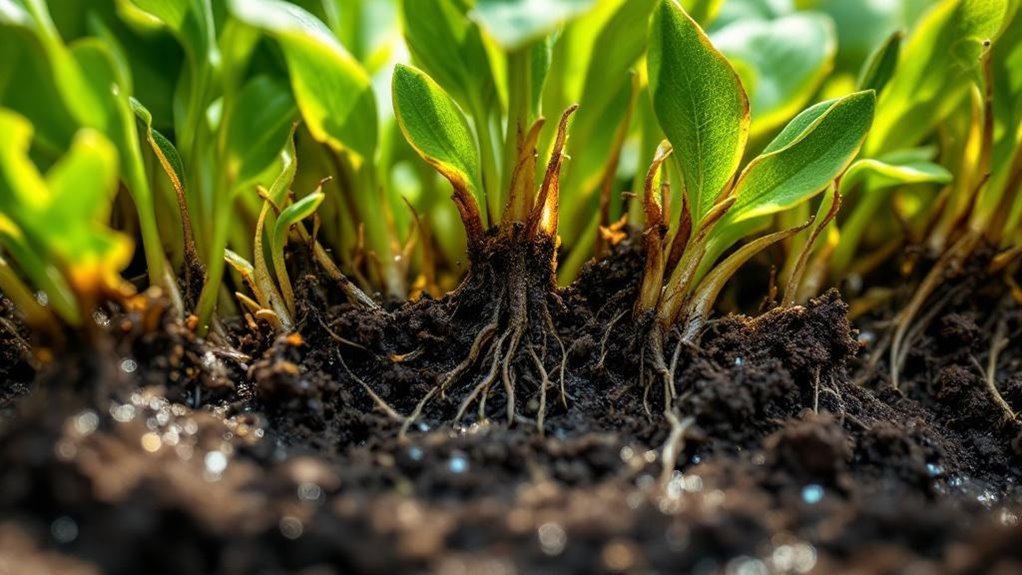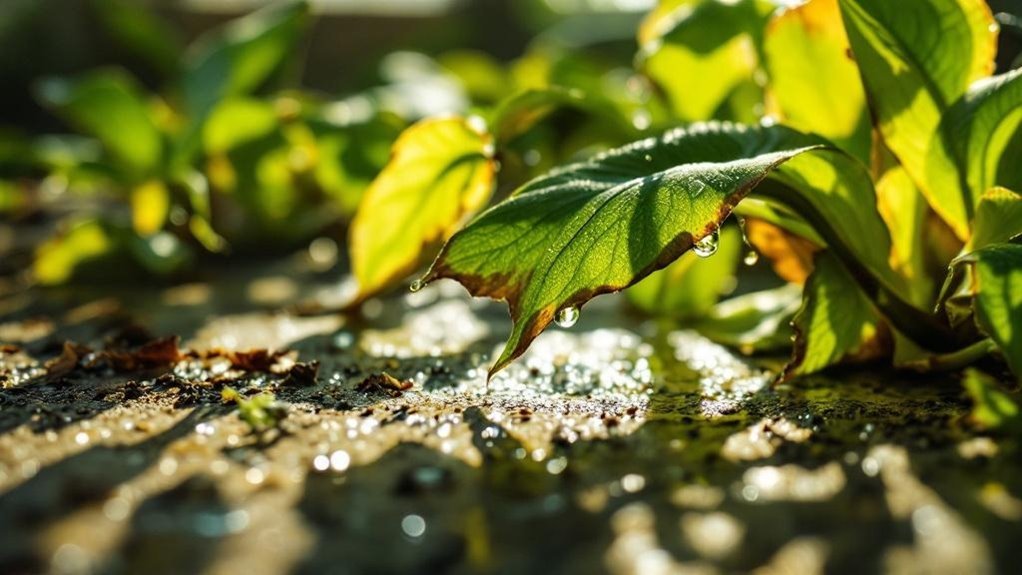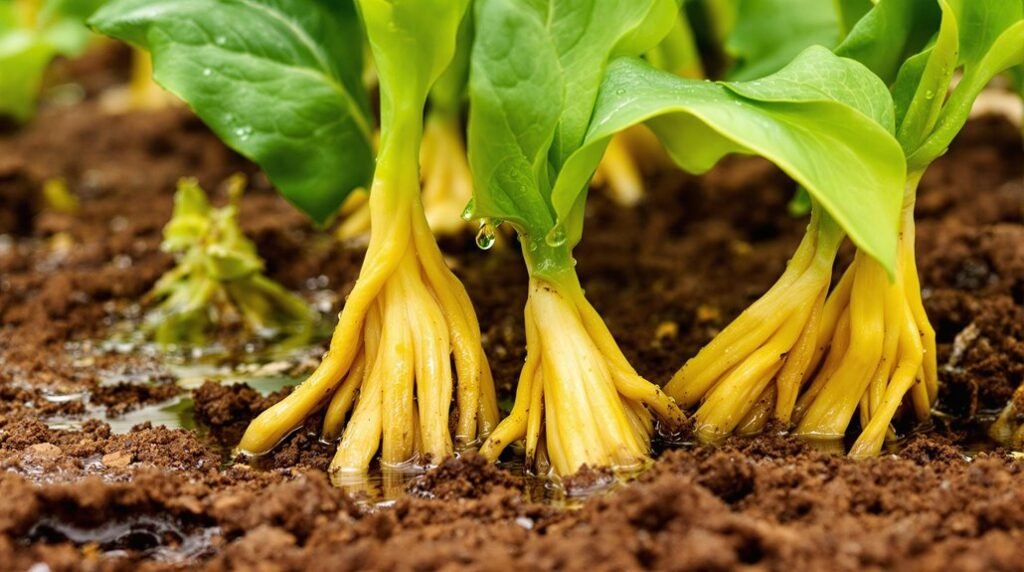You might think watering your plants regularly keeps them healthy, but what if they’re still wilting? It’s frustrating when you do everything right, yet the leaves droop and fade. The issue often lies beneath the surface, involving factors you may not suspect—like soil conditions, root health, or environmental stresses. Understanding these hidden causes can make all the difference in saving your plants.
Common Causes of Plant Wilting
Although you might be watering your plants regularly, wilting can still occur due to several underlying issues.
Poor soil drainage can trap water, limiting oxygen to roots and causing root hypoxia, which leads to wilting.
High temperatures increase transpiration, making your plant lose water faster than it absorbs from the soil, resulting in drooping leaves.
Over-fertilization may build up salts in the soil, creating osmotic stress that blocks water absorption and causes wilting.
Compacted soil restricts root growth and oxygen availability, so even moist soil won’t prevent wilting.
Additionally, vascular diseases like Verticillium wilt clog the plant’s xylem vessels, disrupting water transport and causing wilting regardless of how much water is in the soil.
Understanding these causes helps you tackle wilting effectively.
Signs of Overwatering and Root Damage
When you overwater your plants, their leaves often wilt and turn yellow, feeling soft and floppy due to root damage.
Consistently wet soil moisture limits oxygen availability, causing root hypoxia and weakening roots. This damage shows through stunted growth, a foul smell from waterlogged soil, and blackened or mushy roots if you inspect them.
Constantly wet soil suffocates roots, leading to stunted growth, foul odors, and mushy, blackened roots.
Wilted leaves are a clear sign that overwatering is stressing your plants, making them more vulnerable to diseases.
To catch this early, check the soil moisture regularly—if it’s soggy, cut back on watering.
Overwatering not only harms root health but also invites pathogens that worsen wilting.
Recognizing these signs helps you adjust care and prevent lasting root damage, keeping your plants healthy and vibrant.
The Impact of Soil Drainage on Plant Health

If your plants keep wilting despite watering them properly, poor soil drainage might be the culprit.
Soil drainage plays a vital role in plant health because it guarantees roots get enough oxygen while absorbing water. When drainage is poor, waterlogged soil creates anaerobic conditions that suffocate roots, leading to root hypoxia and making plants vulnerable to root rot.
Even with adequate watering, your plants won’t thrive if their roots can’t breathe or absorb nutrients efficiently.
To improve soil drainage, consider adding organic matter, checking for compacted soil, or installing raised beds. These steps enhance water flow and aeration, reducing wilting risks and promoting stronger root systems.
How Temperature Extremes Affect Wilting
Because extreme temperatures directly impact how plants manage water, they often cause wilting even if you’ve watered them properly. High temperature extremes increase transpiration, making plants lose water faster than they can absorb it from soil.
Even when soil temperatures seem adequate and there’s plenty of water in the soil, root overheating can reduce water uptake, causing your plant to wilt. On the other hand, low temperature extremes stress plants by damaging cells and restricting root function, which also leads to wilting.
Some plants, like cucumbers and squash, are especially vulnerable during heat stress and may lose fruit due to insufficient water absorption.
To prevent your plant wilt, keep soil temperatures stable and avoid exposing plants to harsh temperature extremes that disrupt water management.
The Role of Light in Preventing Wilting

Temperature extremes aren’t the only factor causing your plants to wilt despite proper watering; light plays a significant role as well.
When your plant doesn’t get enough light, it struggles with photosynthesis, which reduces energy and weakens its ability to uptake water effectively. This can lead to wilting even if you’re watering correctly.
To prevent this, gradually move your plant to a brighter spot so it can acclimate without stress. Adequate light improves transpiration, helping your plant balance water loss and absorption.
For sensitive plants, providing dappled shade during the hottest hours can prevent wilting caused by intense light.
Keep an eye on your plant’s leaves—wilting often signals insufficient light, so adjusting its environment can restore its health and liveliness.
Understanding Root Health and Pot Size
Although you may water your plants properly, wilting can still occur if their roots aren’t healthy or have insufficient space.
Root health is essential for water uptake, and even if moisture in the soil seems adequate, compromised roots due to poor drainage or overwatering can’t absorb it effectively.
If your plants are root-bound in a pot that’s too small, their roots get cramped, limiting nutrient and water access and causing wilting.
Soil compaction around roots also restricts oxygen, harming root function and leading to similar symptoms.
Choosing the right pot size and ensuring good drainage can improve root health. For example, repotting into larger containers or using breathable fabric pots helps roots expand and breathe, reducing wilting caused by root stress. Additionally, regular testing with soil testing kits can help identify any nutrient deficiencies affecting root health.
Strategies for Reviving Wilted Plants
If your plants start wilting, you can revive them by addressing key factors like soil drainage and light exposure.
Proper drainage is crucial to prevent waterlogged soil that suffocates roots. Also, make sure your plant gets enough water without overdoing it—maintain consistent watering by letting the top two inches of soil dry before watering again. Additionally, using quality soil mixes, such as those enhanced with Myco-Tone fungi, can promote healthier root development and improve overall plant resilience.
Ensure proper drainage and water only when the top two inches of soil are dry.
Here’s how you can support reviving wilted plants effectively:
- Improve soil drainage to avoid root hypoxia and stress.
- Gradually increase light exposure, avoiding sudden direct sunlight.
- Prune damaged leaves to focus energy on new growth.
Frequently Asked Questions
Why Are My Plants Wilting Even After Watering?
You’re likely overwatering or dealing with poor drainage, causing root oxygen loss. Check for compacted soil, disease, or heat stress. Your plants can’t absorb water properly, so they wilt despite moist soil.
What Causes Plants to Wilt if They Are Not Watered?
Imagine running a marathon without water—you’d collapse from dehydration. When you don’t water plants, they lose turgor pressure, causing wilting. Without moisture, their cells can’t stay firm, so you’ll see droopy, lifeless leaves.
Why Is My Plant Wilting but the Soil Is Wet?
Your plant’s wilting despite wet soil likely means its roots are drowning from overwatering or poor drainage. Check for root rot or compacted soil, which stop oxygen flow and water absorption, causing those droopy leaves.
When a Plant Doesn’t Have Enough Water, It Will Wilt And?
You’d think a plant could survive a desert, but when it lacks water, it wilts and its cells lose turgor pressure, making it droop and weaken—like it’s begging you for a revitalizing drink.
Final Thoughts
If your plants are wilting despite adequate watering, don’t just water more—check the soil drainage, assess root health, and watch the temperature. Don’t ignore compacted soil, avoid over-fertilizing, and manage light exposure carefully. You can revive your plants by diagnosing the real problem, adjusting care routines, and providing the right environment. Remember, wilting isn’t just about water; it’s about balance, attention, and understanding what your plants truly need.
